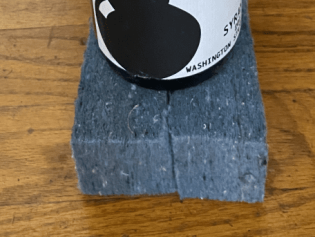New Concepts in Manufacturing & Packaging
Taking Thermal Protection & Durable Packaging to a New Level

EZ Thermo®Card
EZ Thermo®Card is a unique, innovative method for increasing the diversity and performance of various fibers (cotton, hemp , red cedar bark, etc.) to create a material more renewable, more sustainable, and substantially more durable than Expanded Polystyrene (EPS). Depending on its placement in a container (the grain of the fiber), it can add to the strength of the entire package or structure.
This method creates more R-value per inch than other methods and, as you can see from the photographs, by limiting compression you can better maintain protection and R-value under load. This makes it an ideal insulation for protecting and maintaining temperature while shipping heavy temperature-sensitive products such as heavy bottles of wine. Depending on the product being shipped, EZ Thermo®Card can reduce the amount of refrigerant needed and, in some cases, e.g., overnight shipping, you may eliminate the need for refrigerant altogether. The end-product lends itself to a number of other applications, beyond packaging, such as insulation for housing, sound-proofing, etc. Cuts, shapes and molds without the danger of snapping into pieces during handling.
METHOD FOR MAKING A RIGID FOAM SUBSTITUTE (US patent app. 403.18-100) [Excerpt]
Expanded polystyrene (EPS), is used in everything from construction insulation to packaging material, but few realize the environmental and health hazards that EPS pose. For one, EPS is resistant to photolysis and takes more than a million years to decompose. Though EPS can be recycled, the recycling market place is minuscule, meaning that most people could not recycle it even if they wanted to. Additionally, the main component of EPS, styrene, has been identified as a possible carcinogen by the International Agency for Research on Cancer.

The health of people exposed to manufacturing processes involving styrene derived products could suffer as a result. Further, people who use products made of styrene could be exposed to styrene that leaches from said products. These people could also be exposed to benzene and dioxins as well, considering both chemicals are used in EPS production. All of this combined, accounts for a hidden cost of using EPS that has not necessarily been considered by much of the population.
Additionally, because EPS is petroleum based, it is virtually impossible to forecast long-term cost because of the volatility of the petroleum marketplace. This is not the case, with renewable resource natural fibers that enjoy a virtually inexhaustible supply, from both original and recyclable sources. For these, and other reasons, such as having a rigid foam substitute for both thermal and protective packaging applications, we developed a "green" natural fiber product, in combination with a natural, non-poly binder, that is both earth-friendly and cost-effective.
The key to versatility lies with the molds. Depending on the mold we can make tubs, sheets, or widgets. This allows us to do virtually everything expanded polystyrene can do. Another key is drying the end products under controlled temperature. There are several viable/economical options for this, including the use of solar panels and phase-change materials. The beauty of this technology is that virtually all of the equipment required cam be purchased "off the shelf." This reduces cost, not only in initial outlay but also maintenance. Ease of understanding the system shortens the learning curve for operation, as well.
Robotic Manufacturing of 1-Piece Containers
New From Thermopod® - A Robotic System For Laminating and Erecting a One-piece Insulating Container (US patent 62/717,140 - 2018-8-10) [Excerpt] Some years back we invented the first "green," two-piece, insulating container. We trademarked it Thermokeeper®. We knew, then, that the ultimate solution was a "green," one-piece, insulating container. We have recieved three separate patent applications for the construction and assembly of different iterations/templates of a "green," one-piece, insulating container.
In conjunction with the 'green," one-piece, insulating container patent applications, we have filed the above-listed, "game-changing," patent application for automatic assembly of those containers. This cost-effective automated system eliminates the profit-killing cost (and the labor-attendant problems), inherent in hiring large numbers of minimum-wage workers to set up and hand-place insulation in containers. In contrast to the inefficiencies and hazards of hand-placement, robotics guarantee precise insulation placement, and thereby guard against "edge effect" leaks (of hot or cold air), that can compromise the cold chamber. While a worker may not be as precise in their work, after a few hours, robots are as exacting in the 20th hour as they were in the first hour.
The consequences of cold chamber failure can be devastating. It is estimated that our robotic system can complete from 8-10 units per minute which is 12,000 every 20 hours; 84,000 per week; 4.2 million in 50 weeks. Think of the number of minimum-wage employees it would take to achieve this. The relatively quick payback for this system is a huge plus. Another prime consideration, is the ability to cut middleman and transportation costs by locating the machines near a client's largest markets. Containers and insulation are virtually always near these markets, as well. This system was designed for the largest users. We also have a one-piece configuration/template that allows for hand-construction, to accommodate smaller users.